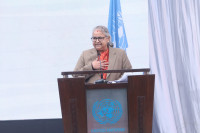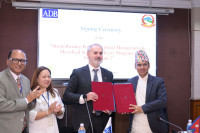National
Falling enrollments worry Nepali universities
The institutions are mulling over merger of colleges for better resource mobilisation.
Binod Ghimire
The universities in the country are witnessing a decline in student enrollments to the extent that they are either mulling over shutting down their different programmes or college mergers.
All the universities including Kathmandu University, which has earned a name in quality education, are struggling to fill their seats. “Some 30 percent of our seats are vacant. If the present trend continues, we will have to shut some of our programmes,” said Bhola Thapa, vice chancellor at the university.
The Kathmandu University runs around 200 programmes under seven schools in Kavre and Lalitpur. Except the School of Law, all other schools under the university are running short of students. The university has a capacity to enroll 6,000 students annually in its constituent and affiliated colleges combined.
Among 3o7 seats under the School of Arts, for instance, only 152 students have been enrolled in different programmes. Student enrollments in programmes like Bachelors in Nursing under the School of Medical Science too are poor. Records at the University Grants Commission, the government entity that oversees university education, show that the overall student enrollment at the universities has declined.
The total number of students at the universities stood at 466,828 in the fiscal year 2019-2020, which fell to 460,826 in 2020-2021. The number of students in the Tribhuvan University slipped to 347,269 in 2020-2021 from 356,654 the previous year. In Kathmandu University, the student numbers decreased to 16,046 from 18,643 during the same period.
The gradual decline in the enrollments has prompted the commission to ask the universities to opt for mergers. Presenting a concept paper on college merger on Tuesday, Govinda Nepal, a member at the commission, said merger of the colleges with low enrolment is a must to control the wastage of resources. “Continuing with the colleges that have very low enrollments is nothing but a waste of money and time. There must be a merger among such colleges after developing a proper modality,” said Nepal.
A report by the commission showed that 624 colleges—constituent, community and private—under different universities have less than 100 students. An additional 277 colleges have less than 200 students. They make up for more than 50 percent of the total colleges—1,440—being operated under different universities.
The officials at the universities say the noticeable decline in enrollments started in 2020 following the Covid pandemic. “We thought that the numbers would bounce back after the pandemic was over. However, they haven’t,” Brajesh Mishra, associate director of admissions at Kathmandu University, told the Post.
He said due to a significant increase in the numbers of students travelling abroad for higher education and the low success rate in the grade 12 examinations has decreased the pool of students at the university level. Some 114,000 students acquired No Objection Certificates (NOCs) from the government in the previous fiscal year for higher studies abroad. Similarly, around 13,000 went to India. The NOC is not mandatory for studying in India. The number of students receiving the NOC has already crossed 80,000 in the first eight months of the current fiscal year.
“We aren’t worried for Kathmandu University, alone. It is a national issue. We need to clear the negativity about Nepali universities in the students,” said Thapa.
He said his university is starting a programme to provide job placement opportunities, run courses in a collaboration with prestigious academic institutions from different countries and make efforts to attract foreign students. Kathmandu University has requested Nepali missions abroad, the embassies of different countries in Nepal and the education consultancies to make efforts to attract foreign students.
In its three decades of operations, 5,039 students from 55 countries have graduated from the university. “We have new programmes and provide competitive education. The students can get quality education,” said Thapa. “We even have the potential to attract foreign students. What we need is a collaborative effort.”




 7.12°C Kathmandu
7.12°C Kathmandu















